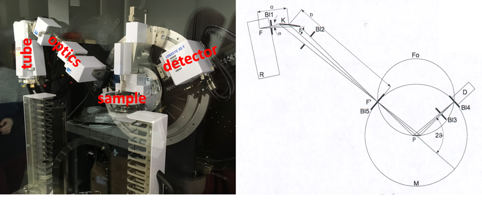ECTS
4 crédits
Structure de formation
Faculté des Sciences
Liste des enseignements
Au choix : 2 parmi 3
Compléments en chimie des solutions
2 créditsCrystallography I
2 créditsAnalyse de biomolécules par spectrométrie de masse
2 crédits
Compléments en chimie des solutions
Niveau d'étude
BAC +4
ECTS
2 crédits
Structure de formation
Faculté des Sciences
Ce cours de chimie des solutions a pour but d’introduire les différents concepts nécessaires à l’étude des mélanges liquides complexes mis en œuvre en chimie séparative. L’approche proposée est principalement thermodynamique. On explique en particulier le rôle des effets de concentration, au delà des lois idéales valables seulement pour les solutions diluées.
CM : 12 H
TD : 8 H
Crystallography I
Niveau d'étude
BAC +4
ECTS
2 crédits
Structure de formation
Faculté des Sciences

This lecture, entirely provided in English, gives a basic introduction into crystallography and electron diffraction for beginners. X-ray diffraction is an important characterization technique in modern chemistry the majority of crystalline structures in inorganic and organic solids have been solved by this method. It is therefore of importance for all students to have an understanding of its basic concepts and instrumentation. The course provides explanations and principles of X-ray diffraction together with the geometry and symmetry of X-ray patterns. Beside interaction principles of X-rays and matter, it treats how to obtain quantitative intensities for single crystal and powder diffraction patterns. It naturally includes the understanding of lattice planes and the reciprocal lattice concept together with the Ewald sphere construction. Further on it gives a basic understanding of the Fourier transform relation between the crystalline structure and the diffracted intensities as well as the reciprocal lattice concept.
Electron diffraction is a complementary technique to X-rays that provides information in terms of symmetry and geometry on the materials studied. In this course, we will therefore approach the description of the method for obtaining electron diffraction pattern and their interpretation. We will be able to obtain the lattice parameters, the reflection conditions as well as the groups of possible spaces.
This lecture serves also as the introductory part to the lecture Electron Microscopy and Crystallography II
CM :14
TD :6
Analyse de biomolécules par spectrométrie de masse
Niveau d'étude
BAC +4
ECTS
2 crédits
Structure de formation
Faculté des Sciences
Connaissance des techniques les plus récentes de spectrométrie de masse pour l’analyse qualitative de molécules organiques et biomolécules.
1) Description des principes fondamentaux (Sciences et technologies des ions) :
- Techniques d’ionisation
- Techniques d’analyse
- Spectrométrie de masse en tandem (MS/MS)
- Couplages LC/MS et LC/MS/MS
2) Application dans le cadre d’analyses de biomolécules et de suivi de réactions de chimie organique.
Volumes horaires* :
CM : 15 H
TD : 5 H

